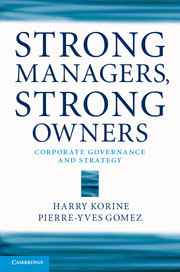Book contents
- Frontmatter
- Contents
- List of Figures
- List of Tables
- Foreword
- Acknowledgments
- Introduction
- Part I Changes in the identity of ownership and management
- Part II Changes in the form of ownership and organization
- Part III Changes in strategy
- 5 Corporate and business strategies
- 6 Despite failure, no change in ownership, management, or strategy
- 7 Because of success, reinforcement of ownership, management, and strategy
- Concluding remarks
- Part IV Implications for corporate governance
- Notes
- Index
6 - Despite failure, no change in ownership, management, or strategy
from Part III - Changes in strategy
Published online by Cambridge University Press: 05 December 2013
- Frontmatter
- Contents
- List of Figures
- List of Tables
- Foreword
- Acknowledgments
- Introduction
- Part I Changes in the identity of ownership and management
- Part II Changes in the form of ownership and organization
- Part III Changes in strategy
- 5 Corporate and business strategies
- 6 Despite failure, no change in ownership, management, or strategy
- 7 Because of success, reinforcement of ownership, management, and strategy
- Concluding remarks
- Part IV Implications for corporate governance
- Notes
- Index
Summary
Why do firms change ownership, management, or strategy? One of the most significant drivers of change in business is failure. Failure, that is to say failure to meet performance expectations, is at the origin of many, if not all, of the changes we have discussed in this book: changes in ownership, because the original shareholders have run out of money or patience; changes in management, because the executives in place are unable to give the organization direction; and changes in strategy, because the firm or the business is poorly positioned to cope with the competition. Of course, change is also driven by generational transition (i.e., succession of ownership or management) and anticipation (i.e., planning in strategy or management), but, in a market economy, the threat of failure is always an important spark for action. And yet, in some cases, ownership, management, and strategy do not change, despite failure. Thus, there are firms that decline progressively and lose money for years, without triggering strategic change. There are also firms that experience significant discrete setbacks without showing any apparent reaction. These cases of no change seemingly contradict the underlying argument that changes in ownership, management, and strategy, are adaptive measures necessary for ensuring the long-term health of the firm.
- Type
- Chapter
- Information
- Strong Managers, Strong OwnersCorporate Governance and Strategy, pp. 135 - 145Publisher: Cambridge University PressPrint publication year: 2013



